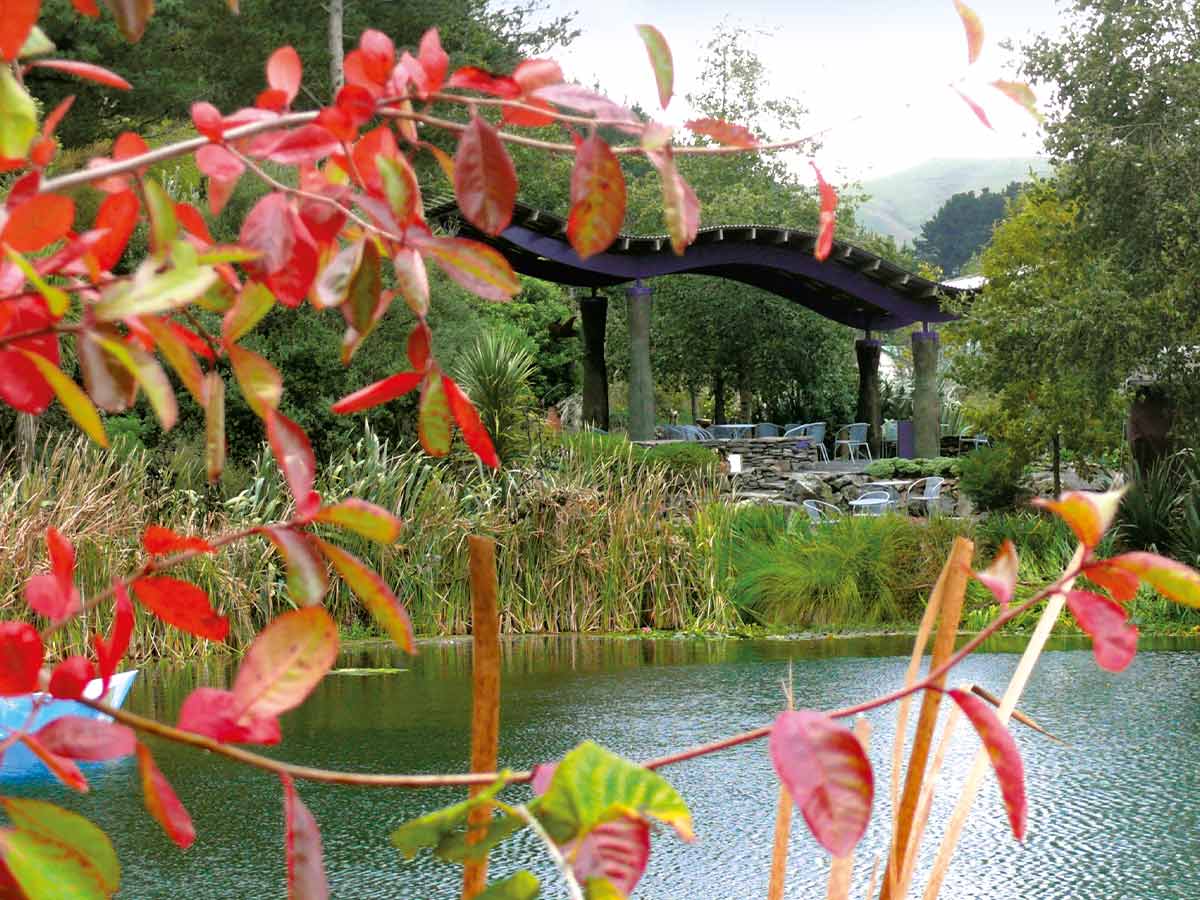There’s nothing quite like a secret garden and the accompanying joy of discovery. While Hamilton Gardens deservedly enjoys its reputation as one of New Zealand’s most-visited attractions, just 20 minutes away, nestled into hills on the outskirts of Hamilton, is a lesser-known but equally deserving destination: The Sculpture Park at Waitakaruru Arboretum.
Once a derelict disused quarry site, grey and bleak with few signs of nature, these days the 17-hectare hillside side is teeming with wildlife and native birds, 30,000 plus trees and shrubs, and a beguiling collection of more than 100 sculptures and garden art, many from some of New Zealand’s most respected artists.
The formerly barren Tauwhare site now features a picturesque central pond, where acoustic walls of rock (soaring as high as 30 metres) prove perfect as nature’s auditorium and have hosted many outdoor concerts and events.
The astonishing transformation from a bleak wasteland is very much a labour of love at the hands of property owners John and Dorothy Wakeling, along with an army of community help and volunteers.
Most days the dedicated couple can be found welcoming visitors, weeding, planting, or working in the background, maintaining the mammoth legacy they’ve created. Their home is set among their plantings, so they truly do constantly live and breathe their workplace.
“When we bought the property in the early ’90s, we wanted to plant trees and live among the trees we planted, watch them grow, and the landscape around us change,” says Dorothy.
Mission accomplished. Their delightful wooden home is snuggled down in the midst of the green haven they’ve created, overlooking Waikato hills and their extensive plantings. Hugging the house are extensive natives and shrubs, as well as ponds rich with frog life, fountains, and a mesmerising array of sculptures and garden art.

“When we were looking for somewhere new to settle, we didn’t want to buy valuable agricultural land,” reminisces John. “At the time, the 10-acre block lifestyle concept was soaring in popularity. It was actually just on a whim that we looked at the old quarry at Tauwhare. It definitely wasn’t a sought-after property; in fact, the real estate agent couldn’t be bothered to show us the site.
“However, once we spotted it, we were instantly hooked, captivated, and enraptured. The workings from the hard-rock quarrying had created a landscape so different from the smooth, rolling hills of nearby. The views over the Waikato flood plain to Pirongia, Karioi, and the Hakarimata Ranges weren’t too bad, either.
“The quarry had its own charm – even as it was. It was a relic – a piece of industrial history that supplied Waikato with gravel. However, the quarry workings left behind a place with a strange skeletal beauty that could only come of human activity on a large scale.”
It was definitely a challenge to transform this landscape into something so polar opposite – a nature sanctuary of sorts, but what a worthy undertaking.
John and Dororthy’s love for the property hasn’t waned over the decades and while Waitakaruru Arboretum represents more than 30 years of painstaking effort, it’s fair to say there have been times that the scope of the project, and funding it, has put the couple under pressure.
“We’re just lucky that along the way, other people passionate about the property have been involved, and from time to time, we’ve gratefully received some donations and grants, which have proved invaluable. The project has depended heavily on the goodwill and support of many people.”

Open seven days a week, The Sculpture Park and Waitakaruru Arboretum are equally appealing for those who enjoy a meander around gardens and nature, as well as those who appreciate art and sculpture, and families keen to enjoy a destination that encapsulates all that’s wonderful about nature and exploring.
“We get a deep satisfaction from other people’s enjoyment of the park,” says Dorothy. “One of our aims is to inspire imaginations, nourish minds, and provide for creative leading in an accessible wilderness environment.”
What originally started as a rehabilitation project has evolved into a property of significance, both artistically and as an arboretum. Alongside the impressive native New Zealand species are rare trees and shrubs from around the world, some of which are endangered in their own habitats. They have been planted according to origin in groupings: Australian, Asian, South American, American, and New Zealand.
Almost 300 of the trees are labelled with a numbering system, enabling visitors to use the Tree Guide John and Dorothy have meticulously put together, and identify the species, common name, and location within the arboretum.
Starting off with a cohesive plan to work with the 30-metre sheer cliffs, steep, and rock-strewn slopes, the sweeping curves of the quarry roads created a natural framework where form followed function. Dealing with the proliferation of noxious weeds was one of the more backbreaking endeavours.
There had been no requirement for the former quarry owners to rehabilitate the land, so it was overgrown with gorse and weeds.
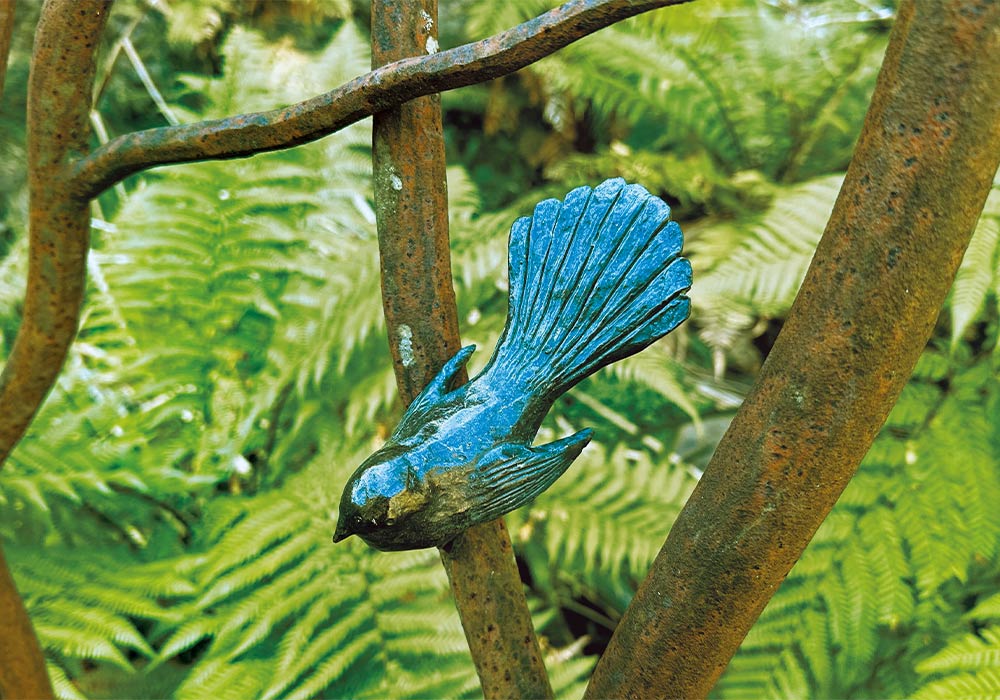
“We did map out an overall plan. Some of the geographical locations were mostly accidents of history and occasionally by design; nonetheless, this method seems to have worked quite well, although, there are times when it’s a bit of a limitation. For example, the Asian section was too small for the variety of trees that interested us from China, Japan, and India. We chose that particular valley, however, because of its misty appearance in winter – a bit like a Chinese painting and it has now been expanded with more than 100 species.
“We were given lots of advice on what to plant and ignored most of it,” admits John. “In total, there were about 10 acres with some original topsoil, and we planted this with pines. They grew well and we’ve maintained them in a silvicultural regime that one day could ensure some economic return.
“All other planting had to wait until we cleared the gorse and pampas, so we progressed bit by bit, year by year, until now, when most of the property has been planted.”
When it comes to sourcing and planting trees, specialist trees were invested in, and keeping cost implications in mind, recycled plants have also played a crucial role, with discarded plants from friends and gifts from nurseries lovingly tended and appreciated. Additional plants have been propagated from cuttings and in situ planting of seeds.
The property has also proven a useful ‘dumping ground’ for repurposing Waikato topsoil, which has been stripped from new subdivisions and roadsides. Clearly equipped with enormous patience and resilience, John’s background as an arborist has been invaluable, and Dorothy with her expertise in environmental planning has been equally involved, particularly in growing the sculpture park and interactive components of the property, which now includes an outdoor team building game called Out Of The Box (Unconfined), with challenges and clues dotted around the trail. This addition has proved popular with social and corporate groups looking for something fun to do, with team-building components, and those who enjoy it often return with friends.
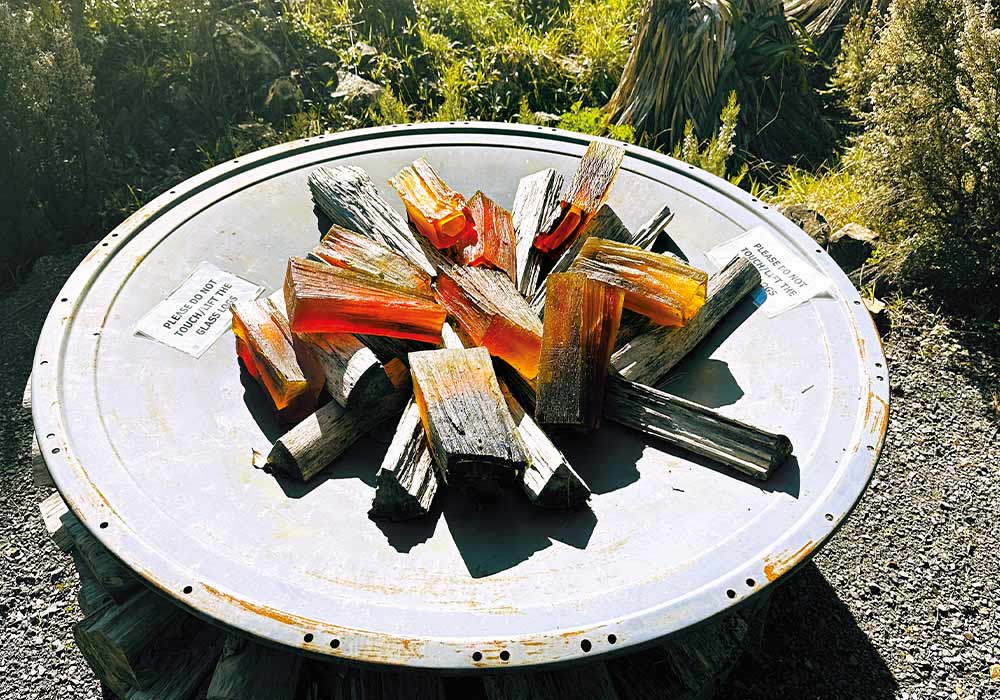
The Sculpture Park itself meanders along approximately two kilometres of pathways, with roughhewn stairways etched into hills and a variety of paths to explore. Works vary from ceramic offerings to carved wooden pieces, multimedia, and majestic metal creations – each with its own story and uniqueness to appreciate.
There’s no time for looking down at your phone while exploring here; around each corner and tucked away under and in trees are pieces of art and sculpture, as well as roosting rurus – so many, in fact, that there’s a ‘Find The Roosting Ruru’ map where youngsters (and all ages) can play hunt the ruru and tick them off as the venture around the park.
For those exploring on foot, a small waterfall and stream trickle through now mature trees, with gentle sounds of water adding to the constant chorus of birdsong. The native owl (ruru/morepork) has become an official emblem of the park, with several rescued ruru joining those who found their way naturally. The growth of nectar and fruit-bearing trees has encouraged the return of tūī, bellbirds, native wood pigeons (kererū), herons, kingfishers, and even kākā.
Tucked away in the heart of the sculpture park and arboretum and overlooking the pond amphitheatre is a delightful cottage (available on Airbnb) – Ruru’s Nest Retreat, an added treat for those wishing to truly immerse themselves in this special spot.
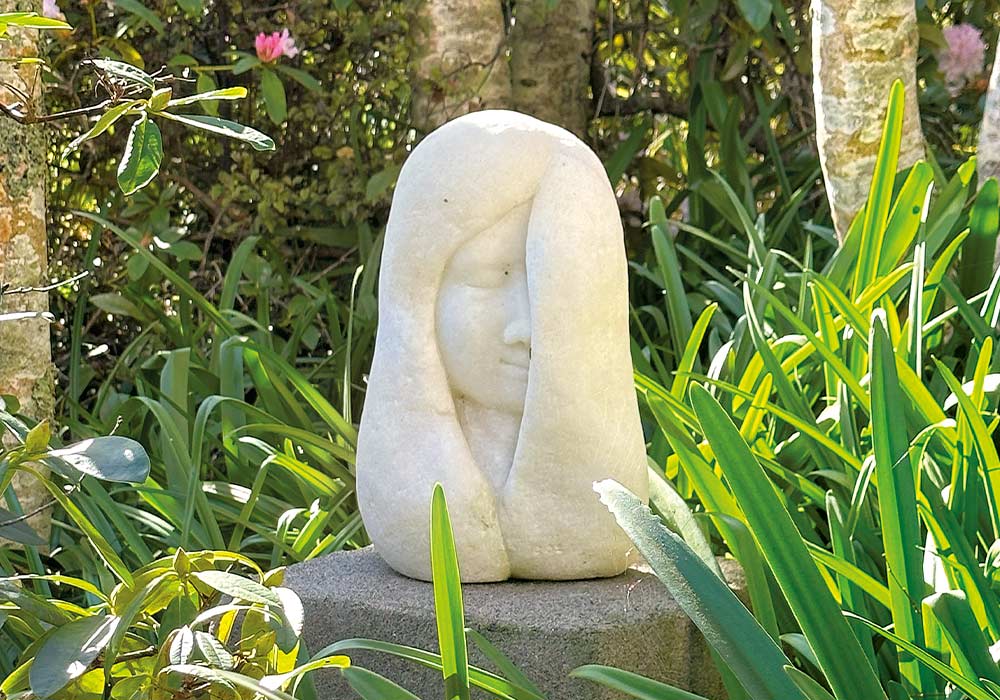
For many years, the park has been home to fundraisers for Hospice Waikato, and 25 different sculpture exhibitions have been held bringing in fresh work to sit alongside the semi-permanent collection of sculptures and installations.
With a thoughtfully designed outdoor seating area, on-site coffee container (with hot and cold drinks, Duck Island ice cream, and snacks) and the Ruru’s Nest Gift Shop, plan to spend the best part of a day here for full enjoyment (the creative play area is a definite drawcard for those with families). There’s ample parking for motorhomes on the lower-level parking area.
With so many aspects to enjoy, this is a destination well worth dedicating some time to.
Open from 10am to 4pm daily, visitors are welcome to enjoy at their leisure or guided tours can be arranged on request and availability. Run as a charitable trust, entry fee is $15 per adult, which helps contribute to the constant upkeep and evolution of this spectacular environmental project.
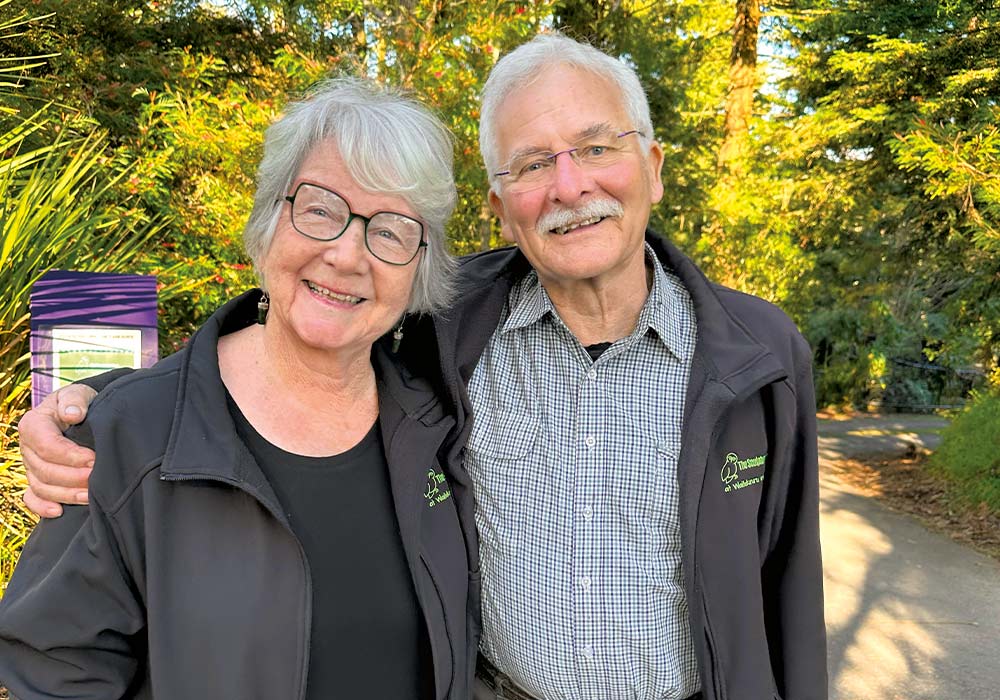
5 things to know
- Make sure you grab a map and tree guide at the office before exploring. There’s so much to see that without these, it’s easy to miss key sculptures, shrubs, and trees.
- Pay close attention to the signs. Some sculptures have accompanying QR codes, which link to a video or additional information about the artist or creative process.
- Download the family activity sheets before you go (The Scavenger Nature Hunt, Exploration of Sound, and other activities) for an added layer to the experience.
- Get a copy of Find The Roosting Ruru sheet from the office. It’s not just for kids to enjoy and make sure you don’t miss any of the fun ruru nesting in trees or hiding in plain sight.
- Once a month (check sculpturepark.co.nz for dates), The Sculpture Park hosts a Dog Walk Day where your canine companion can also enjoy the outdoor adventure. Also check for workshops, special events, and visiting artists.

